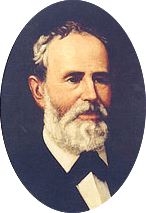Elisha M. Pease
| Elisha M. Pease | |
|---|---|
 | |
| 13th Governor of Texas | |
|
In office June 8, 1867 – September 30, 1869 | |
| Lieutenant | Vacant |
| Preceded by | James W. Throckmorton |
| Succeeded by | Edmund J. Davis |
| 5th Governor of Texas | |
|
In office December 21, 1853 – December 21, 1857 | |
| Lieutenant |
David Catchings Dickson Hardin Richard Runnels |
| Preceded by | James W. Henderson |
| Succeeded by | Hardin Richard Runnels |
| Member of the Texas Senate from District 7 | |
|
In office 1849–1851 | |
| Preceded by | John B. Jones |
| Succeeded by | Adolphus Sterne |
| Member of the Texas House of Representatives | |
|
In office 1846–1847 | |
| Personal details | |
| Born |
January 3, 1812 Enfield, Connecticut |
| Died |
August 26, 1883 (aged 71) Lampasas, Texas |
| Political party |
Unionist Republican |
| Profession | Politician |
Elisha Marshall Pease (January 3, 1812 – August 26, 1883) was a Texas politician. He served as the fifth and thirteenth governor of Texas.
A native of Enfield, Connecticut, Pease moved to Mexican Texas in 1835. He soon became active in the Texas independence movement and after the Texas Revolution began, Pease became the secretary of the provisional government and co-wrote the new Texas Constitution. After independence had been won, Pease was named the comptroller of public accounts in the government of the new but temporary Republic of Texas.
Following the annexation of Texas to the United States, Pease was elected to the Texas House of Representatives in 1845 and reelected in 1847. In 1849, he ran for the Texas Senate from District 11 (Brazoria and Galveston counties) but lost to John B. Jones who was sworn in on November 5, 1849. Pease contested the election, was declared the winner, and was sworn in four days later on November 9, 1849.
Pease first ran for governor in 1851 but withdrew from the race two weeks before the election. He was elected in each of the next two elections, 1853 and 1855. As governor, he paid off the state debt and established the financial foundation that the state would later use to finance its schools and colleges.
In 1856, surveyor Jacob de Córdova of the Galveston, Houston, and Henderson Railroad Company named a newly discovered river in West Texas the "Pease River" after the governor.[1]
During the American Civil War, Pease sided with the Union. After the war, he became a leader in the state Republican Party and was appointed as the civilian governor of Texas in 1867 by General Philip H. Sheridan who was the military head of the Reconstruction government. Pease's policies as governor alienated both ex-Unionists and ex-Confederates and he resigned in 1869.
Pease died of apoplexy in Lampasas, Texas. He was buried in Oakwood Cemetery in Austin, Texas.
Notes
- ↑ Pease River from the Handbook of Texas Online. Retrieved 30 October 2006.
References
- Elisha Marshall Pease from the Handbook of Texas Online
- Griffin, Roger, "Connecticut Yankee in Texas: A Biography of Elisha Marshall Pease." (Ph.D. dissertation, University of Texas at Austin, 1973).
External links
| Wikimedia Commons has media related to Elisha M. Pease. |
- Entry for Elisha M. Pease from the Biographical Encyclopedia of Texas published 1880, hosted by the Portal to Texas History.
- "Elisha M. Pease". Find a Grave. Retrieved 2009-04-11.
| Texas Senate | ||
|---|---|---|
| Preceded by John B. Jones |
Texas State Senator from District 11 (Brazoria) 1849–1851 |
Succeeded by Adolphus Sterne |
| Political offices | ||
| Preceded by James W. Henderson |
Governor of Texas 1853–1857 |
Succeeded by Hardin R. Runnels |
| Preceded by James W. Throckmorton |
Governor of Texas 1867–1869 |
Succeeded by Edmund J. Davis |

